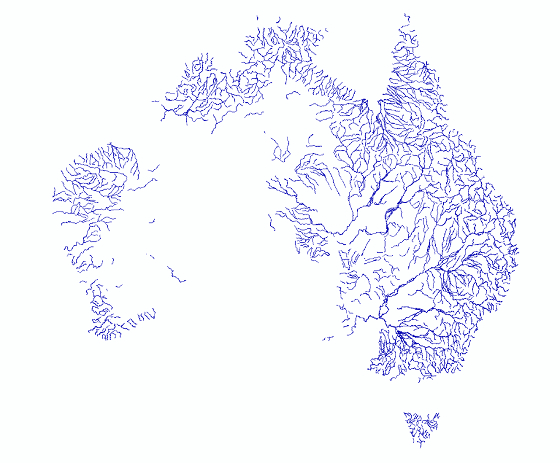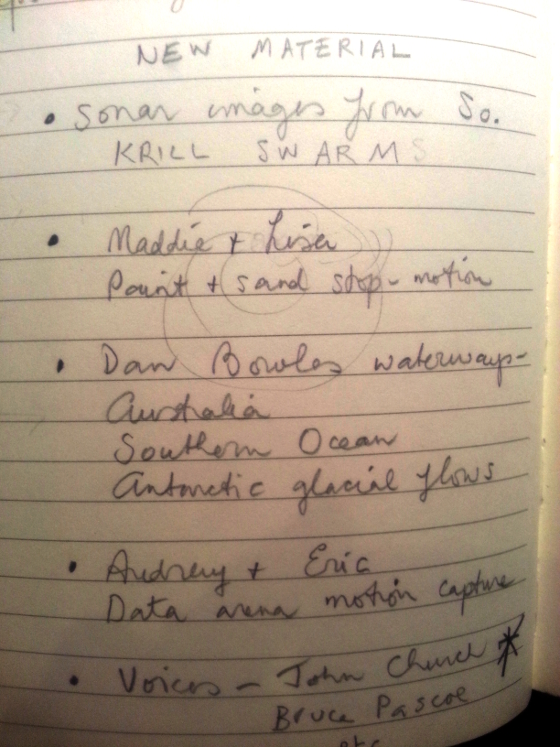Living Data:
Arena
2019 Conversations
Disclaimers, Copyrights and Citations
Conversations/Index 2010 2011 2012 2013 2014 2015 2016 2017 2018 2019 2020 2021 2022 2023 2024
"Mother Earth births everything for us.
Father sky carries the water and oxygen for us to breathe."
Yuin Elder Max Dulumunmun Harrison, 2009
OCEANIC INTERFERENCE
Jason Benedek, William Gladstone (Bill) and I, Lisa Roberts, brainstorm ideas for an animation to create with fellow animator Maddison Gibbs, for presentation at the SC-HASS conference in Ushuaia, in April 2019: Antarctic Connections at the End of the World: Understanding the past and shaping the future.Maddie and I had just returned from researching at the Australian Antarctic Division in preparation for our presentation.
Here the conversation is about how to make an animation to relate Indigenous cultural flows to scientific data, of natural cycles of change in waterways within Australia, the Southern Ocean and Antarctica, and human disruptions to these cycles. Cultural flows are stories held within our lands and waterways that are known and passed down for future generations through song, dance, drawing and other practices. The stories teach how to live with, not against, nature.
As I record and transcribe the conversation I'm aware of myself trying to make clear my meaning to people watching, who may not have the knowledge and experience that my collaborators do, of Indigenous ways of being, knowing and doing. At times it seems like I'm teaching grandma to suck eggs. (That's an old English saying for teaching someone about something they already know, and probably know more than the person who thinks they're teaching.)
Maddie is a Barkanji woman who makes art for understanding and sharing knowledge of her country on the Murray Darling River, a purpose that is strengthened by the recent massive fish kills there. (Maddie sent her apologies, she was busy animating.) Bill works as a scientist with Indigenous peoples in Australia and the Middle East, to understand and recommend protection of traditional fishing grounds and practices. Jason works as a new media artist with Indigenous Australians, to witness, record and promote traditional fire management. My cultural knowledge was limited by growing up in a family that was divided in acknowledging our Aboriginal heritage, limits that expand by reconnecting with family, Elders and other people who are willing to share knowledge.

Jason Wing (right) helps Maddison Gibbs set up for animation.
I trace and animate glacial flows from Antarctica and set these to music by Eric Avery, a Bundjalung, Gumbaynggirr, Ngiyambaa and Yuin, man from NSW.

Maddison Gibbs in the UTS Data Arena immersed in animated data of Sea levels rising (Church et al.) and Antarctic krill (Kawaguchi et al.)

Australian waterways map supplied by Dan Bowles
TRANSCRIPT
LR:
We're talking about the linear nature of scientific and academic arguments, or statements, or stories, and Indigenous ways of telling stories that are the opposite. They're circular. There's a lot of repetition, and people literally sit in circles when they meet together, particularly in large gatherings. And they'll spend days going around in the circle singing their part of the song... So this is an opportunity to ... make a film that shows a shift from the linear to the circular.

JB:
This is very interesting because in terms of digital technology already you've got 'off' and 'on' here. So there's already interesting levels of... hearing just how you graphically describe it.
LR:
And [notes] I've got here, 'Archival footage', New Material', and animated words. And when I looked at the archival footage, one of the key things was your [animated] piece, 'Interference'.
JB:
Oh yeah, why is that?
LR:
It just seemed to bring together all these elements.
JB:
Agreed. Sure... it was with the dancer... Caterina Mocciola... Yeah, I'm proud of that piece. I like everything about it actually, which is unusual for me. It's just one of those things that worked.
LR:
So we've got 20 minutes...to introduce it, screen it, and then take questions. During that 20 minutes I'd really like to encapsulate where Living Data came from, the many voices. We have moved, I think, to this more integrated place here. We've got Indigenous and Non-Indigenous knowledges, we've got art and science. We've got more and more scientists who make art contributing. So we've come a long way and I'd like to show that. We did this in the spirit of inclusion and cooperation.
So this is the message that Maddie and I have come up with, ... with encouragement from a scientist:
The spirit of inclusion and cooperation
that sustained Aboriginal Australia
for tens of thousands of years
is the same spirit that drives
the Antarctic Treaty
and all treaties
to grow and share knowledge.
That's all very rosy and idealistic, but within all this I would love to cut through with crap, with what's threatening this cultural flow that wants to happen so strongly now.
JB:
You want to highlight these disruptions for what they are...
LR:
Yes. So areoplanes flying over the Vestfold Hills and scaring animals and plants...
JB:
Mountains of plastic...
LR:
Yes!...
JB:
This is what Interference was about. Oceanic mountains of plastic. I like this because you've got the line going into a circle, but you've also got the 'off' and 'on', that you can turn that up as zeros and ones. There's lots of rich animating possibilities there...
LR:
And there's your material, Bill, of seagrass and fishes, I think would be fantastic, and I notice you're doing a series of dawns, and that's a really powerful Indigenous idea, that every day is a new beginning...you know this... so in amongst all this crap you have dawns...
JB:
So these are dissonant movements and then you've got dawns that are more holistic...
BG:
And some underlying rhythms to it all - like lunar rhythms...
LR:
Lunar rhythms!
BG:
It's looking like a piece of music. The lines, the way you've broken it up like that...
JB:
Yeah, stave lines and bar lines, minims and riffs.
LR:
So we need that structure to hold the complexity.
JB:
I like it. It's a way of understanding it as evolution, and these disruptions that are breaking into it, messing it up.

BG:
So is it moving from one state to another?
LR:
I'd like it to be cyclic. You know, ABA form, an improvisation structure...














